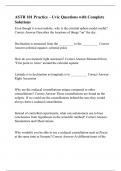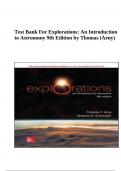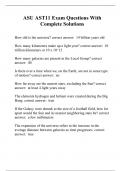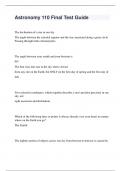What is an ecliptic - Study guides, Class notes & Summaries
Looking for the best study guides, study notes and summaries about What is an ecliptic? On this page you'll find 69 study documents about What is an ecliptic.
All 69 results
Sort by

-
Astronomy 101 Test #1 (Chapters 1-4) Questions with Complete Solutions
- Exam (elaborations) • 13 pages • 2024
-
- $15.49
- + learn more
How long does it take the Earth to orbit the Sun? Correct Answer-one year What is the name given to the path of the Sun as seen from Earth? Correct Answer-Ecliptic The ecliptic is best described as a(n): Correct Answer-plane How many months apart are Winter Solstice and the Vernal Equinox? Correct Answer-3 months Over what place on Earth is the Sun directly overhead on the Autumnal equinox? Correct Answer-the equator When you are facing Polaris you are... Correct Answer-...facing ...

-
ASTR 101 Practice – Uvic Questions with Complete Solutions
- Exam (elaborations) • 37 pages • 2024
-
- $16.99
- + learn more
Even though it is not realistic, why is the celestial sphere model useful? Correct Answer-Describes the locations of things "on" the sky. Declination is measured from the _________ to the __________ Correct Answer-celestial equator; celestial poles How do you measure right ascension? Correct Answer-Measured from "First point in Aries" around the celestial equator Latitude is to declination as longitude is to __________ Correct Answer-Right Ascension Why are the zodiacal constella...

-
UWRF Astronomy Final Exam Questions and Answers 100% Solved correctly
- Exam (elaborations) • 26 pages • 2024
- Available in package deal
-
- $7.99
- + learn more
What does a spectrometer measure? a) resolution b) how much light of each color is coming from a sky object c) subtended angle between stars d) length of a sidereal year - Answer-b) how much light of each color is coming from a sky The apparent path of the sun, moon, planets, and zodiac across the sky is called the a) equator b) celestial equator c) ecliptic d) horizon - Answer-c) ecliptic What is special about the stars Mizar and Alcor in the Big Dipper? a) they are actually a system...

-
Test Bank For Explorations: An Introduction to Astronomy 9th Edition by Thomas (Arny)
- Exam (elaborations) • 535 pages • 2024
-
- $28.49
- + learn more
Test Bank For Explorations: An Introduction to Astronomy 9th Edition by Thomas (Arny) Directly above Earth's equator lies the ________ in the sky. A) North Celestial Pole B) South Celestial Pole C) Celestial equator D) ecliptic Answer: C Difficulty: 1 Easy Section: 01.01 Topic: Locating Objects in the Sky Bloom's: 1. Remember Gradable: automatic Subtopic: Celestial Sphere Model 2) All celestial objects rise in the east and set in the west because A) Earth is rotating from east to ...

-
Science Bowl Astronomy Questions and Answers Already Passed
- Exam (elaborations) • 26 pages • 2024
- Available in package deal
-
- $9.99
- + learn more
Science Bowl Astronomy Questions and Answers Already Passed A solar eclipse can only occur at a: A. full moon B. new moon C. 1⁄2 gibbous moon D. 1⁄4 gibbous moon Answer: B Which of the following constellations cannot be seen in the summer sky of the northern hemisphere? A. Libra B. Orion C. Ursa Major D. Cygnus Answer: B What percent of stars in the sky that appear to be single stars are actually binary stars: A. about 90% B. about 50% C. about 20 % D. about .5% Answer: B T...

-
AST 111 Final Exam – Cumulative || All Correct.
- Exam (elaborations) • 13 pages • 2024
-
Available in package deal
-
- $11.49
- + learn more
7 protons and 8 neutrons correct answers N-15 (7 protons) is an isotope of nitrogen. Its nucleus consists of: absorb correct answers A Hydrogen atom with its electron in the second energy level can ________ energy so that the electron moves to an energy level farther from the nucleus. rising gas below the photosphere correct answers Granulation is caused by: Ozone (O3) correct answers As mentioned in class, the molecule that is most responsible for blocking gamma-rays from space is: ...

-
ASTR 1020 - Final Exam Questions and Answers Top Graded 2024
- Exam (elaborations) • 28 pages • 2024
-
- $14.99
- + learn more
Which of the following is the smallest? a) 1 AU b) Size of a typical planet c) 1 light-month d) Size of a typical star - b) Size of a typical planet How are galaxies important to our existence? a) Without galaxies, the universe could not be expanding b) Without galaxies, there could not have been a big bang c) Galaxies provide the gravity that prevents us from falling off Earth d) Galaxies prevent planets from leaving their orbits around stars; e.g., our galaxy prevents Earth from lea...

-
ASU AST11 Exam Questions With Complete Solutions
- Exam (elaborations) • 21 pages • 2023
-
- $12.99
- + learn more
How old is the universe? correct answer: 14 billion years old How many kilometers make up a light year? correct answer: 10 trillion kilometers or 10 x 10^12 How many galaxies are present in the Local Group? correct answer: 40 Is there ever a time when we, on the Earth, are not in some type of motion? correct answer: no How far away are the nearest stars, excluding the Sun? correct answer: at least 4 light years away The elements hydrogen and helium were created during the Big...

-
Astronomy 1345 Exam 1 UTA With Complete Solution
- Exam (elaborations) • 10 pages • 2024
-
- $9.99
- + learn more
If there are about 6000 stars in the entire sky that can be seen by the unaided human eye, about how many stars would be seen at a particular instant on a given dark night from a single location with an uninterrupted distant horizon? - ANSWER 3000 Are the constellations seasonal? - ANSWER Yes. On a summer night many of the constellations you can see are different from the constellations you can see on a winter night. But there are some constellations you can see all year long. In modern a...

-
Astronomy 110 Final Test Guide
- Exam (elaborations) • 87 pages • 2024
-
Available in package deal
-
- $15.99
- + learn more
The declination of a star in our sky The angle between the celestial equator and the star, measured along a great circle Passing through both celestial poles. The angle between your zenith and your horizon is 90°. The Sun rises due east in the sky when viewed from any site on the Earth, but ONLY on the first day of spring and the first day of fall. Two celestial coordinates, which together describe a star's position precisely in our sky, are: right ascension and declination ...

How did he do that? By selling his study resources on Stuvia. Try it yourself! Discover all about earning on Stuvia


